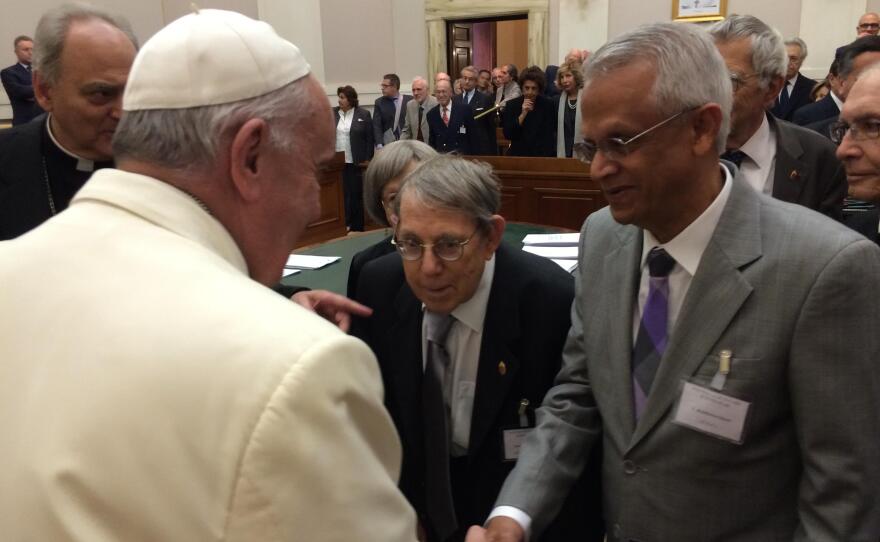I am Maureen Cavanaugh. It is Friday, September 15. The top story , client scientists have been working for years to calculate how a warmer atmosphere might impact human life on earth. Now, scientists have new calculations that bind a small potential for the warming of such significance that it could wipe out human life on earth. The paper introduces two new categories to the potential risk of global warming. That is catastrophic and exit central. The level of climate change would pose an existential threat to human life. Joining me is the lead author of the new study, Doctor, welcome to the program. I'm glad to be here. You review old data as far back as the 1980s to combat -- come up with the new probabilities. What did you review and what did that tell you ? Catastrophic of a threat is simply not in the lexicon of a scientist language, particularly nitrile scientists like me. I was forced or compel to arrive at this risk categorization by the data I had collected over the last 35 years. We launched a climate satellite in the 1980s. I conducted searches and there were drones. When we looked at the data with my students and a scientist working in the lab over the last five years, it was striking that not only had the predictions we had made over the last 25 years have come true but with one exception, the changes were larger than what they had predicted. It also shows the feedback kicking in. How much higher are the predictions now in the new calculations ? For what we are dealing with is when we talk about predictions as we are now, there are uncertainties. The center value of the prediction, it is a 50% probability with unchecked emissions, the planet would enter into dangerous warming. That is 30 years from now. That is the same. What the new data has revealed is that there is a probability that we could reach what we call catastrophic level of warming within 35 years. You can ask, what is a catastrophic warming? It is changes that are so large and so rapid that you have very little time to adapt, similar to what happened with the hurricanes. People did not have time to react. That is what we mean by catastrophic. The probability is 5%. That says, that is pretty low and we should not be bothered. 5% is 1 in 20 with the odds of a plane crash. If I gave you that I -- those odds, we would not get on the airplane. There is a higher level of risks and the new Poppy -- the cancellations that is unknown or existential. There is the potential for the rise in temperatures of 5 degrees Celsius or more. What is the likelihood of this existential threat? If we go business as usual with the unchecked emissions beyond this 2015. He, what we are finding is the warming could be in the range of 5 to 8 degrees. What does that mean? What do we mean by existential threat? There are a combination of thing -- things which compel us to come to this conclusion. First, the recent findings, when you exceed 4 degrees, you expose close to 7 billion in the population. By then, it would be 10 billion. We see 70% would be exposed to deadly heat. The other studies which are showing the so-called [ Indiscernible ] disease, things like [ Indiscernible ] and other viruses. 2.5 billion people will be exposed. That is the public health. How would the echo system fair? They say climate changes could pose existence -- a threat to 20% of the species. If you combine all of this, more drought and more floods and the sea level rises 2 meters and beyond. We conclude that the population is going to be exposed to an existential threat. It does not mean civilization would be wiped out. We do not know that for fact. It tends on who is able to adapt and who is able to escape the risk. It is going to be chaotic. Since your calculations find a greater possibility that global temperatures could rise higher and faster than assumed before, does this mean that the efforts that are made to slow global warming are not working? We are not doing much. So far, the good news is, the compass is turning in the right direction. Take U.S. emissions. That has peaked over a year ago. What we need to do is curb the been and so do the other nations. They created 8 million jobs in the industry but we are calling for more drastic actions and fortunately, there are laboratories -- I will give you an example, close to home. If the entire world followed San Diego and what California is doing,. We still have time fortunately but we have to start now. The new paper on climate change and risk classification is published in the Journal proceedings of the national Academy of sciences. Thank you very much. Thank you
Climate scientists have worked for years to calculate how a warmer atmosphere might impact human life on Earth.
Now scientists at Scripps Institution of Oceanography at UC San Diego have published new calculations that find a small potential for global warming of such significance, it could wipe out life on Earth.
The paper, published Thursday says, there is a one in 20 chance of catastrophic change by 2050, which would mean most people would have problems adapting to the change in climate. There is a smaller chance of an existential change, meaning it would wipe out humanity.
“When we say 5 percent-probability high-impact event, people may dismiss it as small but it is equivalent to a one-in-20 chance the plane you are about to board will crash,” Veerabhadran Ramanathan, lead study author and a distinguished professor of climate and atmospheric sciences at Scripps said in a press release. “We would never get on that plane with a one-in-20 chance of it coming down but we are willing to send our children and grandchildren on that plane.”
RELATED: How A San Diego Scientist Helped Shape The Pope’s Climate Change Plans
The publication coincides with the start of Climate Week NYC which begins Monday in New York. Ramanathan and colleagues will outline the “three-lever” mitigation strategy of emissions control and carbon sequestration on Monday at the United Nations.
On Friday's Midday Edition Ramanathan will discuss his findings.








